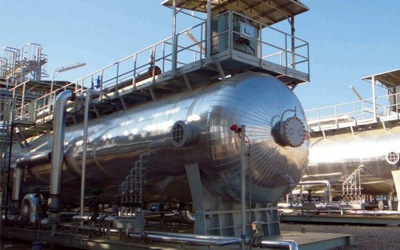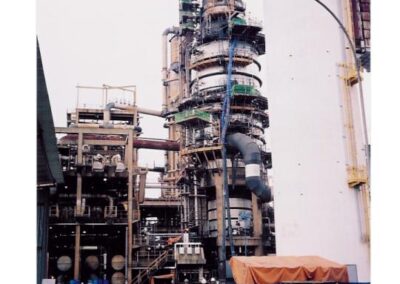Part 5
Part 5, focusing on decontamination of the crude unit, in the series on how the chemical industry is solving challenges in the industrial sector. We will define the crude unit as beginning with the Atmospheric Tower and the Vacuum Distillation Tower to include the associated heat exchangers. We will intentionally leave out the Desalters and the crude oil storage tanks for a separate discussion.
As we discussed in our previous installment, Part 4, product separation is hindered by such things as tower fouling and deposits in the overhead condensers and reboilers. Tray fouling leads to poor contact between the vapors rising through the tower and the liquids in the tower. A fouled overhead condenser can reduce the amount of refluxing that takes place which can reduce the quality of the overhead product. Fouled reboilers increase the cost of fuel consumption required to operate the unit.
Concentrations of hydrogen sulfide present in the crude oil cause equipment corrosion and eventually inorganic corrosion products. Some of the inorganic corrosion products may be pyrophoric iron sulfide deposits in the upper regions of the distillation towers.
When the crude oil preheat bundles become fouled, it results in higher fuel consumption to heat the crude oil in the crude charge furnace. It also means that there will be a decreased capacity to cool the various process streams in the crude unit. This is because the crude is heated in these heat exchangers by cross-heat exchange with the crude unit product streams. Unfortunately, these heat exchanger bundles are the most susceptible to fouling in the refinery. The preheat bundles will become fouled with a coke-like deposit. The operating temperature of the exchangers is not high enough to form true coke (carbon). The fouling typically is not coke, but rather asphaltic in composition along with some percentage of inorganics (iron).
The vacuum tower will become fouled with a mixture of organic and inorganic deposits. Given that the feed to the vacuum tower is from the bottom of the atmospheric tower, the organic deposits are usually asphaltenes.
As these systems must be periodically cleaned to maintain product quality and process efficiency, the crude unit is taken out of service at great expense to the refiner. The major expense is the loss of production, so completing the outage in the least possible time is critical. Maintenance work cannot begin until the equipment is decontaminated and safe for personnel entry.
As the crude unit is taken down from production, the refiner begins a cool-down process utilizing a hydrocarbon liquid to begin cooling the equipment and flushing-out the remaining crude oils present in the towers, exchangers, piping etc. The cool-down step is an opportunity to improve the system process for decontamination of the crude unit and reduce the time required to commence maintenance work.
What if there was a way to use this to reduce or eliminate other steps in the decontamination of the crude unit? Well, there is.
Following cool-down and evacuation of the residual oil, the refiner will begin steaming the equipment to purge gases out and continue with liquid oil removal. In years past, the steaming process took days to achieve the required personnel entry specifications (LEL reduction, H2S removal, pyrophoric iron control). Most recently, contractors introduced the vapor-phase “degassing” process. This process is the introduction of chemicals into the steam to reduce the time involved with equipment steam-outs.
Let’s look at “degassing” more critically. What do the chemicals added to the steam do? It is called “degassing”, but do the chemicals remove gases? The answer is typically no. These chemical products function primarily to “de-oil” the equipment. This is to say, these chemicals aid in the more efficient removal of latent system liquid oils which are the source of continued gas formation in the towers. The primary method for removing actual hydrocarbon gases remains purging the equipment with steam pressure.
Imagine that you could actively address removing hydrocarbon gases by some other means than steam pressure during the decontamination of the crude unit. You can.
Since the “degassing” chemicals are usually alkaline in nature, the chemicals can help to reduce low concentrations of acidic hydrogen sulfide via neutralization. So, now the gases inside then equipment have been purged out, the liquid oils have been flushed-out with the steam condensate and the decontamination of the crude unit is complete… Well, not yet. If the refiner has been processing sour crude oils, there remains the possibility of pyrophoric iron sulfide deposits.
Historically, the process to address iron sulfide deposits is through either acidification with Hydrochloric or Sulfuric Acid or the introduction of oxidizing chemicals such as potassium permanganate. Both processes require that the system degassing be completed first. Additionally, the processes are a separate step requiring more time to address the presence of pyrophoric iron.
Of note, the acidification process results in the generation of copious amounts of hydrogen sulfide gas which must be managed. The introduction of permanganate means the rigorous control of the heat of oxidation to prevent other undesirable events and the creation of substantial amounts of manganese dioxide solids which must also be removed.
Any refiner that has experienced a tower fire or worse understands the importance of controlling the possibility of pyrophoric iron combustion. Not doing so could be catastrophic.
The equipment is now free of hazardous vapor, oils and possible iron sulfide combustion. What remains? As personnel are authorized to enter the towers to commence maintenance work, they often encounter organic solids in the form of asphaltenes mixed with inorganic scales. These materials have typically been removed by physical labor. Unfortunately, disturbing the mass of solids collected on trays and the tower bottom often results in the release of sufficient light-end gases as to require personnel to suspend work inside the towers and begin another course of steaming to purge out the gases from the equipment to allow continuation of the maintenance work.
All of the above options for the decontamination of the crude unit are time consuming. Every hour of lost production is hundreds of thousands of dollars in lost revenue to the refiner. Every measure taken to reduce the time in decontamination means an earlier return to production and profitability.
There are new developments in the world of chemistry that can enhance the critical process for decontamination of the crude unit and can reduce the time required to successfully accomplish clean, safe equipment.



